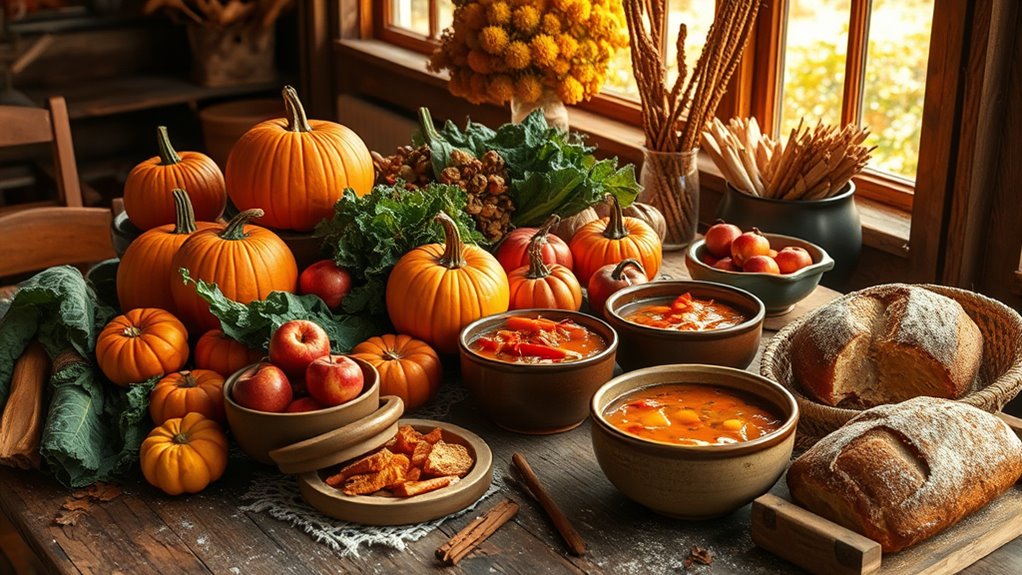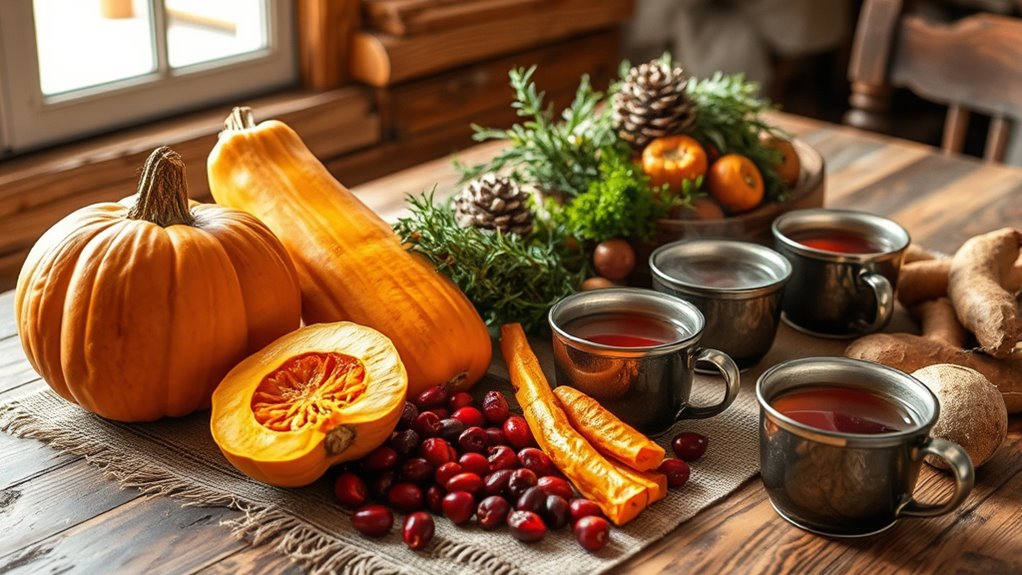Seasonal meal planning for autumn and winter involves choosing in-season ingredients like pumpkins, root vegetables, and hearty greens to create flavorful, nutritious meals. Focus on comforting soups, stews, and casseroles that take advantage of seasonal herbs and spices such as cinnamon and thyme. This approach saves money, reduces waste, and supports local farms. To discover tasty recipes and helpful tips, keep exploring how to make the most of these nourishing seasonal ingredients.
Key Takeaways
- Focus on in-season ingredients like pumpkins, root vegetables, and hearty greens for fresh, flavorful meals.
- Incorporate warm spices such as cinnamon, nutmeg, and thyme to enhance seasonal dishes.
- Plan hearty soups, stews, and casseroles that utilize abundant produce and can be made ahead.
- Support local farmers by buying seasonal produce, reducing costs and promoting sustainability.
- Use seasonal ingredients to create nourishing, comforting meals that maximize flavor and minimize food waste.

Have you ever wondered how planning your meals around the seasons can simplify your grocery shopping and make your dishes more flavorful? As autumn and winter roll in, these seasons bring a bounty of fresh, hearty ingredients that lend themselves perfectly to comforting dishes. By aligning your meals with what’s in season, you’re not only supporting local farmers but also ensuring your dishes taste their best. Think about hearty soups that warm you from the inside out or cozy casseroles that fill your home with inviting aromas. Incorporating seasonal produce like pumpkins, squash, root vegetables, and hearty greens allows you to craft meals that are both satisfying and nutritionally rich.
Planning your meals around seasonal ingredients simplifies shopping and boosts flavor.
When you focus on seasonal ingredients, you’ll find that hearty soups become your go-to for quick, nourishing meals. Imagine simmering a pumpkin or butternut squash soup with a hint of sage, or a robust vegetable stew that features carrots, parsnips, and potatoes. These soups are easy to prepare in large batches, making them perfect for leftovers or freezing for busy days. Plus, they highlight the natural sweetness and depth of flavor that only seasonal produce offers, elevating your everyday meals. As for cozy casseroles, they’re perfect for when you want a dish that can be assembled ahead of time and baked to perfection. Think layered dishes with seasonal vegetables, cheese, and perhaps some leftover meats or beans. A classic chicken and vegetable casserole with kale and sweet potatoes captures the essence of autumn and winter, providing comfort and nutrition in every bite.
By planning your meals around what’s in season, you also minimize waste and reduce your grocery bill. Seasonal produce tends to be more abundant and affordable, so you can stock up and get creative without breaking the bank. You might also experiment with different herbs and spices that are in season, like cinnamon, nutmeg, or thyme, to add warmth and depth to your hearty soups and casseroles. This approach encourages you to be flexible and inventive—substituting ingredients based on what’s fresh and available. The result is a more sustainable, flavorful, and satisfying way to enjoy your daily meals.
Ultimately, aligning your meal planning with autumn and winter’s seasonal offerings transforms cooking from a chore into an enjoyable, mindful activity. It helps you make the most of nature’s bounty while creating comforting dishes that nourish both body and soul. So, start exploring those hearty soups and cozy casseroles, and let the season’s produce inspire your culinary creativity.
Frequently Asked Questions
What’s the Best Way to Store Seasonal Produce?
To store seasonal produce effectively, you should use proper food preservation methods like refrigeration, freezing, or canning. Keep root vegetables in a cool, dark place to maximize their shelf life, and store leafy greens in perforated containers in the fridge to maintain freshness. Proper seasonal produce storage prevents spoilage and extends usability, so always check for signs of decay and use breathable bags or containers to avoid excess moisture.
How Can I Reduce Food Waste During Holidays?
You can reduce food waste during holidays by practicing effective leftover management and smarter holiday meal planning. Start by portioning meals carefully and using leftovers creatively in new dishes, like soups or casseroles. Store leftovers promptly in airtight containers, label them, and plan to consume them within a few days. This approach minimizes waste, saves money, and guarantees you enjoy your holiday bounty without feeling overwhelmed by excess food.
Which Spices Enhance Autumn and Winter Dishes?
You should use spice blends like cinnamon, nutmeg, and cloves to enhance autumn and winter dishes, as they add warmth and depth. Incorporate flavor enhancers like ginger, allspice, and cardamom for a cozy feel. These spices not only boost taste but also evoke seasonal aromas, making your meals more inviting. Experiment with combinations to find your perfect balance, creating comforting dishes that celebrate the flavors of the season.
How Do I Meal Prep for Busy Winter Weeks?
To meal prep for busy winter weeks, start with efficient freezer organization to keep your meals accessible. Use batch cooking techniques to prepare large portions of hearty soups, stews, or casseroles, then divide and freeze them in individual containers. Label everything clearly, so you know what’s inside. This way, you can quickly heat up nutritious meals on busy days, saving time and reducing stress during the colder months.
Are There Healthy Comfort Food Options for Colder Months?
Think of healthy comfort foods as a warm hug on a cold weather day. You can enjoy hearty vegetable stews, roasted root vegetables, or lentil soups that nourish your body and soothe your soul. These meals are packed with nutrients, filling, and perfect for chilly days. Embrace these wholesome options to stay cozy and healthy during the colder months, turning cold weather into a season of comfort and well-being.
Conclusion
As you embrace seasonal meal planning for autumn and winter, consider the theory that eating seasonally boosts your immune system and mood. While some skeptics doubt its health benefits, numerous studies suggest fresh, seasonal ingredients provide more nutrients and flavor. So, next time you plan your meals, trust nature’s cycle—your body might thank you. Embrace the season’s bounty and discover how simple, mindful choices can transform your well-being during these colder months.









